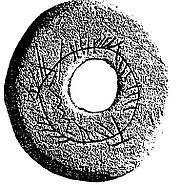
Buckquoy spindle-whorl
Encyclopedia

Spindle (textiles)
A spindle is a wooden spike used for spinning wool, flax, hemp, cotton, and other fibres into thread. It is commonly weighted at either the bottom middle or top, most commonly by a circular or spherical object called a whorl, and may also have a hook, groove or notch, though spindles without...
dating from the Early Middle Ages
Scotland in the Early Middle Ages
Scotland in the early Middle Ages, between the end of Roman authority in southern and central Britain from around 400 and the rise of the kingdom of Alba in 900, was divided into a series of petty kingdoms. Of these the four most important to emerge were the Picts, the Scots of Dál Riata, the...
, probably the 8th century, excavated in 1970 in Buckquoy, Birsay
Birsay
Birsay is a parish in the north west corner of The Mainland of Orkney, Scotland. Almost all the land in the parish is devoted to agriculture: chiefly grassland used to rear beef cattle...
, Orkney, Scotland
Scotland
Scotland is a country that is part of the United Kingdom. Occupying the northern third of the island of Great Britain, it shares a border with England to the south and is bounded by the North Sea to the east, the Atlantic Ocean to the north and west, and the North Channel and Irish Sea to the...
. Made of sandy limestone, it is about 36 mm in diameter and 10 mm thick. It has achieved fame because of its ogham
Ogham
Ogham is an Early Medieval alphabet used primarily to write the Old Irish language, and occasionally the Brythonic language. Ogham is sometimes called the "Celtic Tree Alphabet", based on a High Medieval Bríatharogam tradition ascribing names of trees to the individual letters.There are roughly...
inscription
Epigraphy
Epigraphy Epigraphy Epigraphy (from the , literally "on-writing", is the study of inscriptions or epigraphs as writing; that is, the science of identifying the graphemes and of classifying their use as to cultural context and date, elucidating their meaning and assessing what conclusions can be...
.
The inscription was once used as proof that the Pictish language
Pictish language
Pictish is a term used for the extinct language or languages thought to have been spoken by the Picts, the people of northern and central Scotland in the Early Middle Ages...
was not Indo-European
Indo-European languages
The Indo-European languages are a family of several hundred related languages and dialects, including most major current languages of Europe, the Iranian plateau, and South Asia and also historically predominant in Anatolia...
, being variously read as
- E(s/n)DDACTA(n/lv)IM(v/lb)(s/n/)DDACTANIMVTMIQAVSALL(e/q)
however, in 1995 historian Katherine Forsyth
Katherine Forsyth
Katherine S. Forsyth is a British historian who specializes in the history and culture of Celtic peoples during the 1st millenium AD, in particular the Picts...
reading
- ENDDACTANIM(f/lb)
claimed that it was a standard Old Irish
Old Irish language
Old Irish is the name given to the oldest form of the Goidelic languages for which extensive written texts are extant. It was used from the 6th to the 10th centuries, by which time it had developed into Middle Irish....
ogham benedictory
Benediction
A benediction is a short invocation for divine help, blessing and guidance, usually at the end of worship service.-Judaism:...
message, Benddact anim L. meaning "a blessing on the soul of L.". The stone from which the whorl was made, and on which the inscription was written, is likely to have originated in Orkney.

